Growth | Innovation | The Future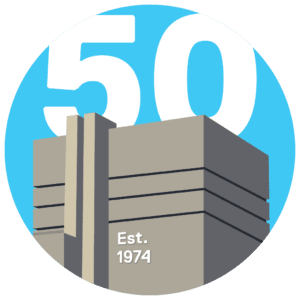
The building
This year, the Library building celebrates its 50th anniversary, a milestone marking an opportunity to reflect back and look ahead to the next fifty years.
In 1974, the Library building—designed by Webb Zerafa Menkes Housden Partnership (WZMP), the same firm that designed the CN Tower (also under construction in 1974!)—opened at the corner of Gould and Victoria, becoming a new landmark for the university.
Discussions for the building began in the late 1960s, with construction beginning in 1972. The brutalist style architecture, which embraced ideals of simplicity and functionalism, complemented the egalitarian function of the library as a place to access information, while also highlighting modern ideas and new ways of thinking. The design was not only forward thinking, it also embodied the creative, scholarly, and practical work happening at the institution and within the Library.
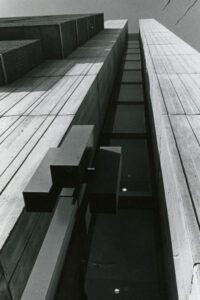
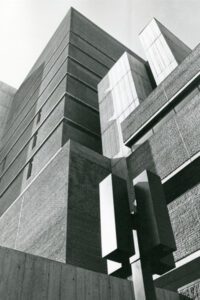
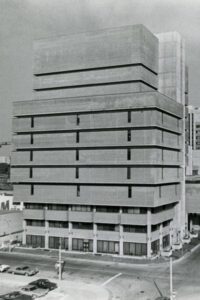
Images courtesy of TMU Archives & Special Collections, RG 122.10.93
___
1970s
When it opened, the Library was called the Learning Resource Centre, and the building was shared with faculties and departments. Throughout the 1970s the Centre (Library) grew, acquiring collections and resources that addressed the needs of a growing academic institution.
Throughout the decade, the Centre introduced new services and outreach programs for students, and embraced innovative technologies for automation and access, becoming, for example, the first library in North America to install IBM’s DOBIS/LIBIS online computer system, which operated all circulation and inter-library loans. Media collections, digitization of resources, and new study and gathering areas helped to facilitate cross-disciplinary collaborations, and highlight the Centre as an ecosystem for research, learning and creative pursuits.
Over the next four and half decades the Resource Centre would become the Ryerson University Library and Archives, and now TMU Libraries. It would (and still) continue to push innovation and advances in academic library services, resources, programming and opportunities for the university community.
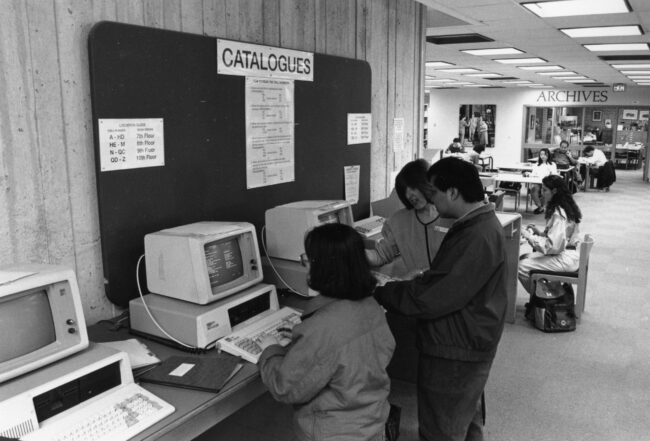
___
1980s
In the 1980s, budget cuts loomed large over academic institutions. Despite cuts, the school continued to grow, and the Library continued to develop collections, services, and programs to meet the expanding needs of faculty, researchers and students.
The Library participated in a new network system developed by engineers at the federal Department of Communications. The network was composed of library terminals that linked to terminals in homes and other education institutions, allowing users to retrieve information from numerous connected databases.
While the system wasn’t sustainable, the Library was on the cusp of what would one day be possible: the sharing of collections across academic libraries.
___
1990s
In the 1990s, technological improvements to searching and accessing information happened quickly. In 1990, two new CD-ROM terminals were installed, which, for the first time put searching and discovery of electronic resources in the hands of library users.
Just one year later, faculty and students were able to access library services and collections via the university’s mainframe, enabling 24/7 access from onsite computer workstations and homes. Library users could now search collections, place interlibrary loan requests, email research help questions, and view research guides from their own computers.
The 1990s also saw the development of the Library’s first website, providing access to the library catalogue, subject research guides, and information about library collections, hours, and services.
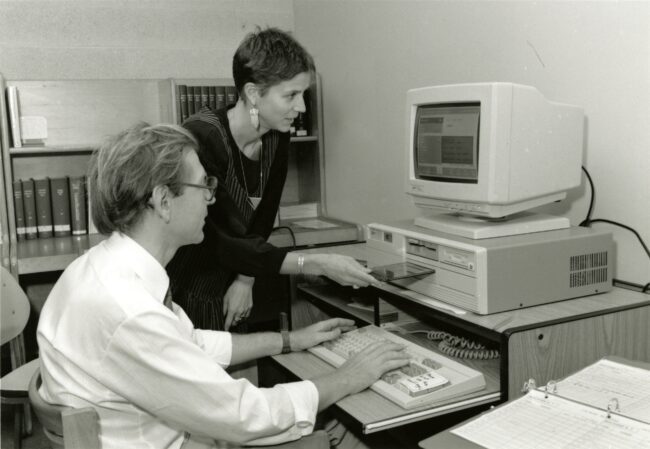
___
2000s
In 2000, the Library introduced its first online chat service, which provided real-time online research help to the community. Users could now get immediate research help from home. In 2002, the Library pioneered a collaborative chat service together with York University and the University of Guelph, which opened up more availability for real-time research assistance. The service continues today as Ask Us, and includes sixteen libraries across Ontario.
Between 2000 to 2010, many changes to the building also took place.
Alumnus Ronald D. Besse donated one million dollars to establish the Ronald D. Besse Information and Learning Commons on the main floor (2nd floor) of the Library. The Commons opened in 2004, with 140 computer workstations that provided access to the internet, electronic resources and productivity software.
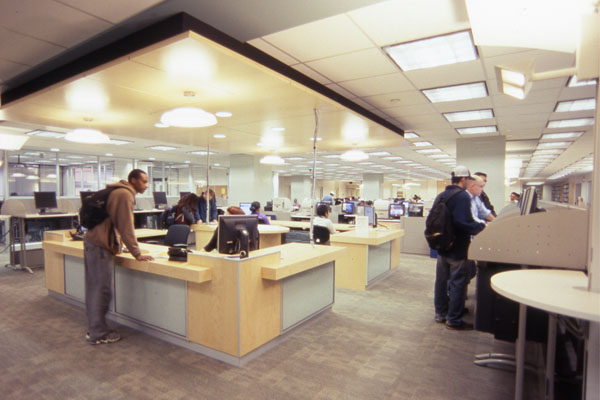
In 2007, the Library renovated the 3rd and 4th floor of the building, adding study space, including five new carrels with state-of-the-art adaptive technology for students with disabilities, and a new home for the University Archives and Special Collections.
___
2010s
In 2015, after receiving a generous donation from Isaac Olowolafe Jr., the Library opened the Isaac Olowolafe Jr. Digital Media Experience Lab (DME). Housed on the 3rd floor of the SLC building, the Library’s DME opened to assist, primarily undergraduate students, in learning basic and advanced technology skills, while providing access to new and emerging technology. The DME quickly became a resource to support student learning in the classroom as well as extracurricular pursuits.
In 2017, the Library Collaboratory opened on the 3rd floor of the Library building. The Collaboratory was, and continues to be, the Library’s first space dedicated to graduate students and faculty in need of collaborative research space, access to technology and technological support. The multidisciplinary research space continues to expand access to technology, including 3D printers, a laser cutter, drones, and prototyping tools.
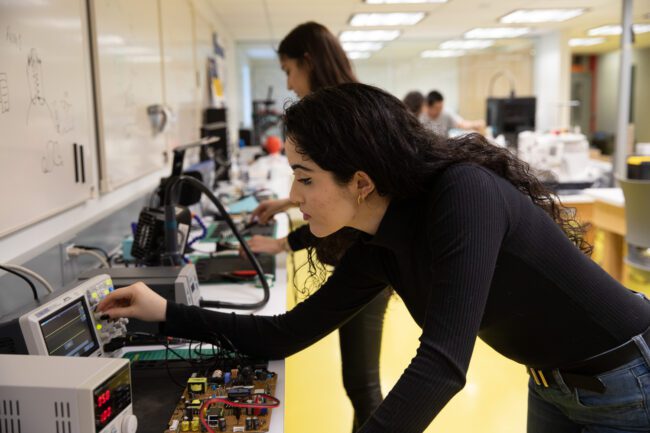
___
2020s
In early 2020, the Law Library opened on the 4th floor of the Podium building. Supporting the new Lincoln Alexander School of Law, the Law Library became the first branch library, and along with the university name change, the Ryerson University Library became TMU Libraries.
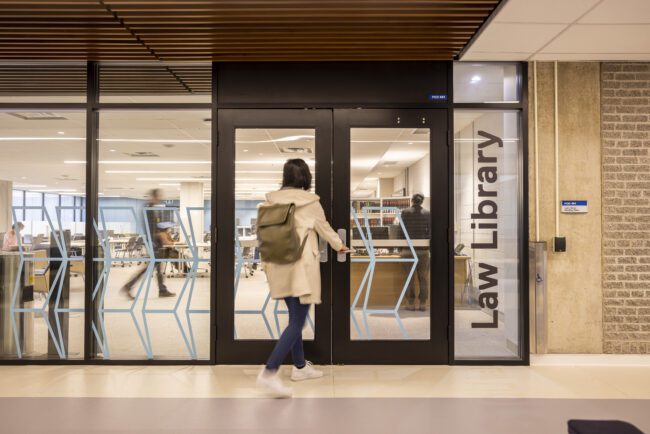
However, shortly after opening, all services went online as the university closed its buildings due to Covid-19. The Libraries quickly adjusted, offering online programming, services, research help, contactless drop offs, and pickups.
Prior to the pandemic, plans were formulating to install an Immersion Studio on the 3rd floor of the Library, and in 2021, those plans were realized, providing students with access to an immersive space to develop projects and present research–all with the support of an immersive technology specialist.
One year later, in 2022, TMU Libraries installed a Material ConneXion collection. The 1000 piece onsite collection of material items was added to complement an online collection of 10,000 items. Students and faculty now have hands-on access to explore a variety of materials representing current trends in design, materials research and production.
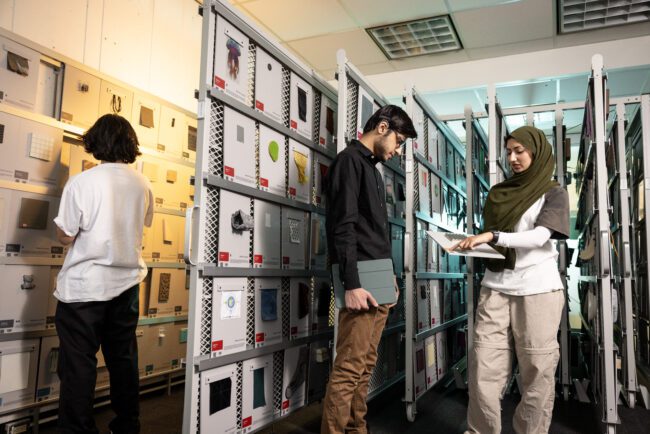
The Libraries opened a Media Production Studio in 2023. The beginner level studio is the first Library space to offer podcasting, video production, and photography in support of creative research endeavors in all subject areas.
And, this year, the Libraries launched Omni, a new search tool which connects the TMU Libraries catalogue to 18 other Ontario university libraries (making, what the Libraries had explored in the 1980s – the sharing of collections – a reality), expanding access to over 25 million material items for all TMU students, faculty, researchers and staff.
What’s next…
Throughout the past 50 years, TMU Libraries has grown to now occupy ten floors of the Library building, and will soon be opening a second branch library supporting the new School of Medicine in Brampton. It has always, and continues to, push innovation in library services and resources, while meeting the needs of the university and advancing the research excellence of our community. The brutalist architecture showcases egalitarian ideals and function, while continuing to be modern and forward-thinking. The building design at the time represented a futuristic view that continues to hold.
Learn more about the Library building and join us as we look towards celebrating the next 50 years of TMU Libraries and the Library building.